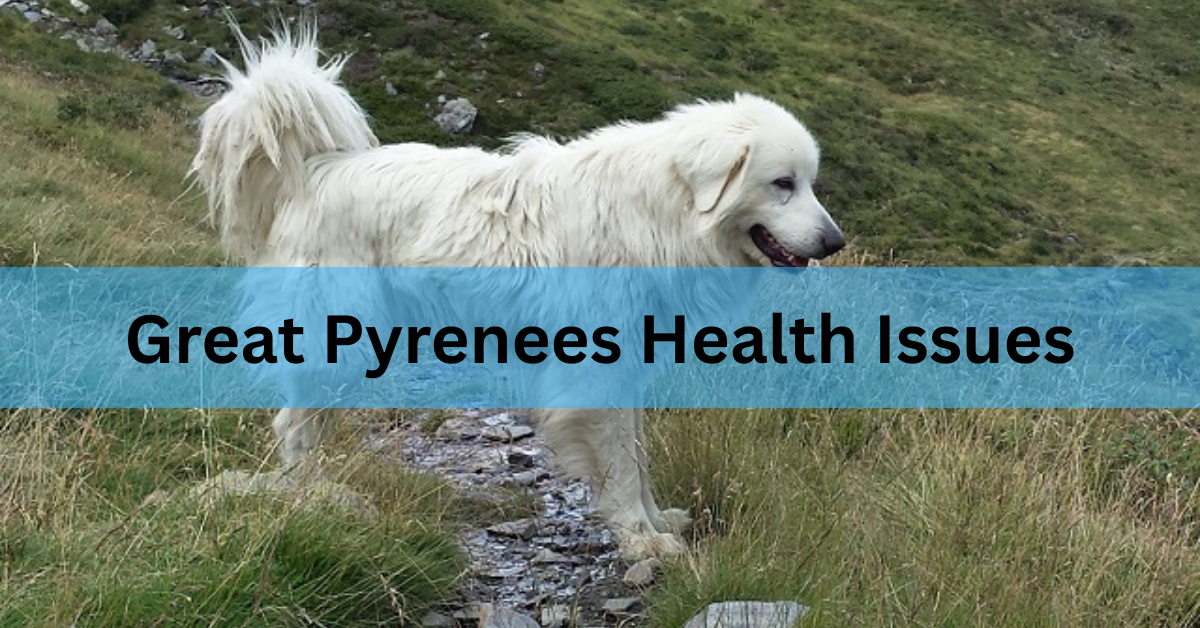Ultimate Guide to Great Pyrenees Health Issues – What Every Owner Needs to Know!
The Great Pyrenees, known for their majestic build and gentle temperament, are loyal, protective, and family-friendly dogs. But despite their strength and resilience, they are not immune to health complications. Like all purebred dogs, this giant breed carries certain inherited and lifestyle-related health risks. Understanding Great Pyrenees health issues is key to ensuring a long, healthy life for your furry friend.
This guide explains everything you need to know in simple terms—from common diseases to preventative care, feeding tips, warning signs, and more.
Introduction: Why Health Awareness Matters
The Great Pyrenees typically lives 10 to 12 years, which is respectable for a giant breed. However, their large size and genetic predispositions make them prone to several orthopedic, cardiovascular, and dermatological disorders. Early awareness can help owners make better lifestyle choices and seek prompt veterinary care when needed.
Whether you’re a new owner or a seasoned Pyr parent, this guide will help you take proactive steps toward managing your dog’s well-being.
Understanding the Breed’s Unique Needs
Great Pyrenees dogs are large, powerful, and deep-chested. These physical traits, while impressive, increase their vulnerability to specific health problems such as joint dysplasia and gastric torsion. Additionally, their thick double coat, developed to protect them in cold climates, can create skin issues in warmer or humid environments if not properly maintained.
Their heritage as livestock guardians means they’re stoic by nature—often hiding pain. That makes it even more essential to know the signs of underlying illness before it becomes serious.
Common Great Pyrenees Health Issues
Let’s now break down the most commonly reported health issues in Great Pyrenees and how you can manage or prevent them.

Hip and Elbow Dysplasia
These are inherited joint disorders where the ball and socket don’t fit properly, leading to arthritis and pain. Dysplasia is more likely in giant breeds due to rapid growth and excess weight pressure on the joints.
Symptoms include:
- Difficulty rising or walking
- Limping, especially after exercise
- Reluctance to climb stairs or jump
Weight control, joint supplements, and early screening via X-rays are essential. In severe cases, surgery may be required.
Patellar Luxation
In this condition, the kneecap slips out of place, causing intermittent limping or an abnormal gait. Though more common in smaller breeds, some Great Pyrenees are also affected due to their body structure and genetics.
Veterinarians typically assess severity in grades, and treatment ranges from physical therapy to corrective surgery.
Degenerative Myelopathy (DM)
DM is a progressive neurological disease that causes weakness in the hind legs and eventually leads to paralysis. It’s often misdiagnosed as hip dysplasia in early stages. Genetic testing can confirm whether your Pyr carries this risk.
Though there’s no cure, physical therapy can help maintain mobility longer.
Gastric Dilatation-Volvulus (Bloat)
One of the most dangerous Great Pyrenees health issues is bloat. This life-threatening condition causes the stomach to twist and fill with gas, cutting off blood supply.
Watch for signs like:
- Restlessness and pacing
- Swollen or tight abdomen
- Dry heaving or unsuccessful vomiting
- Pale gums and rapid heartbeat
Immediate emergency surgery is the only treatment. To prevent it, avoid heavy meals before or after exercise, and ask your vet about preventative gastropexy surgery.
Dilated Cardiomyopathy (DCM)
DCM is a heart disease where the heart muscles thin and become too weak to pump efficiently. Great Pyrenees may not show obvious signs until it’s advanced.
Symptoms can include coughing, shortness of breath, and fainting. Annual heart checks using echocardiograms and blood pressure monitoring are advised, especially after age 5.
Skin Allergies & Dermatitis
Great Pyrenees often suffer from skin issues due to their thick coat. Allergies to food (especially chicken), dust, pollen, and even flea bites can trigger inflammation, itching, and infections.
Common symptoms:
- Red, irritated skin
- Excessive scratching or licking
- Recurrent ear infections
Switching to hypoallergenic diets, using anti-itch shampoos, and maintaining a strict grooming schedule can help. In severe cases, vets may prescribe antihistamines or allergy shots.
Eye Conditions
This breed is genetically susceptible to several eye problems:
- Entropion: Eyelids roll inward, causing lashes to irritate the eye.
- Ectropion: Eyelids sag outward, exposing the inner lid and causing dryness.
- Cataracts and PRA (Progressive Retinal Atrophy): These can lead to blindness if untreated.
Regular eye checkups can detect problems early, and most issues can be managed with medication or surgery.
Von Willebrand’s Disease
This is a genetic blood clotting disorder that makes affected dogs bleed excessively even from minor injuries. There’s no cure, but the condition can be managed once diagnosed through blood tests.
It’s important to inform your vet if your dog is undergoing surgery or dental procedures.
Obesity and Mobility Issues
Due to their calm demeanor, Great Pyrenees can easily become overweight, which worsens joint pain and heart strain. Consistent, low-impact exercise like walking and swimming, combined with portion-controlled meals, is vital.

Avoid overexertion, especially during warm months, as this breed is sensitive to heat due to their dense coat.
Summary Table: Common Health Issues in Great Pyrenees
| Condition | Description | Prevention/Management |
| Hip/Elbow Dysplasia | Abnormal joint formation | Weight control, X-rays, supplements |
| Bloat (GDV) | Stomach twist; life-threatening | Gastropexy, slow feeding |
| Skin Allergies | Itching, hot spots, ear infections | Diet, grooming, antihistamines |
| Heart Disease (DCM) | Weak heart muscle | Heart screenings, meds |
| Cataracts/PRA | Vision loss | Regular eye exams, surgery |
| Degenerative Myelopathy | Nerve degeneration | Physical therapy, genetic testing |
| Von Willebrand’s | Blood clotting disorder | Screen before surgery |
Preventative Health Tips
Nutrition
Feed a high-quality diet specifically formulated for large breeds. Avoid common allergens like chicken if your dog shows symptoms. Always read labels, and avoid fillers or by-products.
Grooming
Brush their coat 2–3 times weekly to avoid matting, skin infections, and pests. Bathe only when necessary with a vet-approved shampoo.
Also Read: Tenet Health Login – Secure Access and Patient Experience!
Routine Vet Visits
Schedule at least one vet checkup yearly, increasing to twice per year after age 6. Include:
- Joint and mobility assessments
- Heart and lung evaluations
- Blood panels for organ function
- Eye and dental checks
When to See a Vet Immediately
Call your vet or emergency clinic if your Great Pyrenees shows:
- Sudden bloating or hard belly
- Loss of coordination or limb weakness
- Heavy breathing or collapse
- Pale gums or uncontrolled bleeding
- Unexplained lethargy or weight loss
FAQs
1. Can Great Pyrenees live in hot climates?
Yes, but only with caution. Provide shade, fresh water, and limit outdoor activity during peak heat hours. Use cooling mats or indoor AC in summer months.
2. How early should I screen my Pyr for hip dysplasia?
Start screening at 12–18 months with X-rays. Early detection helps with timely interventions like physical therapy or lifestyle changes.
3. Are Great Pyrenees more sensitive to anesthesia?
Some studies suggest large breeds may have slower metabolism rates, requiring specialized dosing. Always consult a vet with breed experience.
4. Is crate rest recommended after orthopedic surgery?
Yes. Limited movement helps bones and joints heal properly. Your vet will guide you on time frames based on the procedure.
5. Do Great Pyrenees puppies need special food?
Absolutely. Choose a puppy formula specifically for large breeds to support slow, steady growth and avoid bone/joint issues.
Conclusion
The Great Pyrenees is a majestic, loyal, and intelligent breed that deserves the very best in health care. While they’re prone to a variety of inherited and lifestyle-related conditions, many of these can be managed—or even prevented—with early detection, proper nutrition, regular vet visits, and daily care routines. By understanding the most common Great Pyrenees health issues, you can take proactive steps to protect your beloved dog’s quality of life for many years to come.
Read More:
Family Health Center Alcott – A Comprehensive Guide to Community-Centered Care!
CaroMont Health Careers – Your Guide to a Fulfilling Healthcare Profession!
Ascension Genesys Health Club – Redefining Wellness Through Integrated Fitness and Healthcare!






